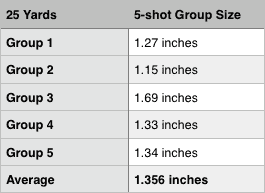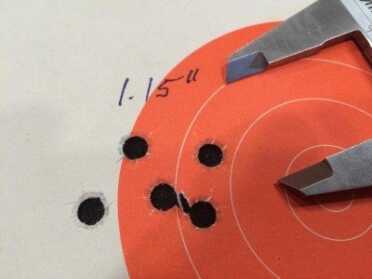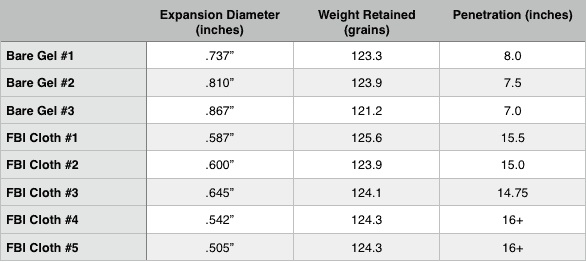
These Sig Sauer V-Crown 9mm bullets expanded perfectly after passing through the four-layer FBI test fabric.
While the Sig ammo is a relative newcomer to the market, the people are not. I spent some time talking with Dan Powers, who runs the ammo show, and it’s clear that the folks behind Sig Sauer’s new ammunition division have been there and done that.
Because every caliber, load and brand combination is different, we’re going to be testing a number of different Sig Sauer loads over the coming weeks. We’ll start the handgun family with Sig’s Elite Performance V-Crown 9mm load.
 This one is a 124 grain standard pressure round, but as we’ll see, it delivers velocity closer to +P territory. The defensive handgun loads use Sig’s V-Crown bullet. Four years in design, it’s being patented as we speak and it’s all Sig Sauer. At this time, and maybe never, you won’t find it out there under other labels.
This one is a 124 grain standard pressure round, but as we’ll see, it delivers velocity closer to +P territory. The defensive handgun loads use Sig’s V-Crown bullet. Four years in design, it’s being patented as we speak and it’s all Sig Sauer. At this time, and maybe never, you won’t find it out there under other labels.
The V-Crown is a jacketed design, and from the exterior, looks like many other hollow-point bullets. The cavity appears to be more sharply conical than others, but that’s the only visible difference. The hollow nose is not particularly wide or cavernous and appears to be about the same size as that on a Speer Gold Dot of similar caliber. When you pull a bullet, you’ll see a cannelure groove half way up the shank. It’s present to help the lead core and jacket to remain united as the bullet travels through objects. What you can’t see is the “stacked hollow point” design that is intended to allow quick and reliable expansion – to a point. Rather than cut one in half and theorize, I shot a number of them into FBI fabric-covered gelatin blocks. We’ll talk about that later.
Accuracy and Velocity
As this is a Sig bullet, I felt it appropriate to test accuracy and velocity using a Sig Sauer pistol. The choice of which one was easy. I used the Sig Sauer P226 Elite SAO. This gun is really somewhat of a cross between a standard P226 and match grade model like the Competition X5. It’s got a single-action trigger and is stunningly accurate. Knowing what the pistol is capable of, I figured the ammo would get a fair test. It’s really consistency, after all, that drives accuracy from an ammo standpoint. Consistency of powder load, consistency of case size and wall thickness, and consistency of bullet construction.
I set up a Shooting Chrony Beta Master chronograph 15 feet downrange and got to shooting. Here’s a typical 10-shot string:
Remember, the chrony was 15 feet down range, not at the muzzle, so expect actual muzzle velocity to be a tad higher. Extreme spread of this particular string measured 54 feet per second with the standard deviation calculating to 15.19. If you’re not a statistician, think of standard deviation as an indication of how close all the individual measurements are to the mean, or average. For ammunition velocity, a smaller standard deviation means all rounds are traveling very close to the same velocity, and 15.19 is good when it comes to ammunition. This indicates that the performance of this ammo probably exceeds the precision of my commercial chronograph anyway. Given the velocity consistency, I was pretty optimistic about accuracy testing.
 For accuracy testing, I improved my sight picture by using a Bushnell Elite 3500 2-6×32 Handgun Scope. Scope a semi-auto you ask? Yes, using the UM Tactical rail mount, you can add an optic to virtually any size-compatible pistol with a Picatinny rail. Anyway, the Bushnell is a great option for the handgun ammo tests in this series. It’s 6x zoom and fine crosshairs are plenty to give even my aging eyes a good sight picture. At just 9 ½ inches long and 10 ounces, it adds little bulk and weight to a handgun setup.
For accuracy testing, I improved my sight picture by using a Bushnell Elite 3500 2-6×32 Handgun Scope. Scope a semi-auto you ask? Yes, using the UM Tactical rail mount, you can add an optic to virtually any size-compatible pistol with a Picatinny rail. Anyway, the Bushnell is a great option for the handgun ammo tests in this series. It’s 6x zoom and fine crosshairs are plenty to give even my aging eyes a good sight picture. At just 9 ½ inches long and 10 ounces, it adds little bulk and weight to a handgun setup.
Placing targets at 25 yards down range, I proceeded to shoot a bunch of 5-shot groups. Since I had no sighting precision limitations using the Bushnell, I decided to measure the full 5-shot group size instead of the best three method I use when shooting with lasers or iron sights.
Do you think it shoots? Umm, yes, I’d say so. If I’ve gotten multi-5-shot-group performance like this before, I don’t remember when.
Shootin’ the jello
Accuracy and velocity are nice, but neither of those means much when it comes to personal defense ammunition. I shot this ammo into both bare and cloth-covered Clear Ballistics gelatin blocks.
The bare gel test is really a gimme. Most any ammunition will expand in picture perfect fashion when fired into bare gelatin. The Sig 9mm V-Crown expanded dramatically every time. You can see the numbers in the table, but each round expanded to more than double its original diameter. As a result, penetration was less than the theorists would like to see. I don’t care, and here’s why. Evil dudes generally aren’t made of bare gelatin. I want to know how ammo performs in terms of expansion and penetration after it passes through clothing barriers. For that, we’ll use the standard FBI 4-layer fabric protocol.
Shooting through clothing barriers makes a huge difference, and performance of most self-defense ammunition starts to get pretty erratic when it has to pass through denim and three additional cloth layers. As you can see from the table, all bullets expanded properly after passing through the FBI fabric and penetration was excellent. The range of expansion was 1.42 to 1.82 times original bullet diameter. I used a single 16-inch long gelatin block, and two exited the back with barely any remaining energy, hence the 16+ penetration measurement.
Bottom line? I’ll carry it.
I’m really looking forward to testing the .357 Sig load, because, hey, it’s a namesake. I’ve also got dibs on a new 230 grain .45 ACP loading. That weight in .45 ACP is notoriously finicky when fabric barriers are introduced, so we’ll see how it does.






Serious question: why no four-layer denim test?I do not recognize this artificial-fleece-coat-and-t-shirt fabric sandwich as being part of any officially endorsed or scientifically constructed protocol for ammunition testing. Where did it come from, and why aren\’t you just using the long established FBI standard of four layers of heavy 16 ounce cotton canvas denim, and why are there no bare gelatin shots so that we can see whether the bullet overexpands and underpenetrates when no fabric is present?No doubt someone in the peanut gallery is saying \”no one wears four layers of denim, that\’s unrealistic.\” Well, no kidding. It\’s supposed to be a worst-case scenario to identify and weed out those bullet designs prone to clogging with clothing. Four layers of denim is SUPPOSED to be a lot. It is SUPPOSED to be hard to design a bullet that will penetrate four layers of denim and still expand reliably, while also not overexpanding and under-penetrating in bare gelatin. Penetration must be 12\” to 18\” both with and without the four layers of denim, and the bullet must expand sufficiently to increase its diameter at least 25% on average both with and without the denim, with at least 90% reliable expansion with the denim present. Not one layer of denim. Not one layer of denim and a layer of flannel. Not a cotton bath towel. Not a leather jacket. Not velour jammies. 16 ounce cotton canvas denim, four layers.
Before you go off like a wounded banshee, perhaps some facts are in order. You are unfortunately mistaken as to the FBI protocol. “Four-layers of denim” has never been an FBI protocol for ballistic testing. You might as well shoot at 4 layers of plywood, because as many people wear that as 4-layers of denim. The protocol used here is the actual FBI Heavy Clothing protocol: 1 layer each of Denim, nylon shell, Polartec fleece and cotton t-shirt. Sorry to burst your bubble.
can you reload the cases? thank you for some info.
Nice how you showed multiple bullet results (velocity & gel tests). Bought a box 11/2015 but haven’t tested for vel. yet (3.4″ Brl. Ruger) at $20 +. Shore would be nice to see you testers stick some pork rib bones in that gel. about 1/4″ in from the front & with that denim! As a game/varmint hunter, I see bullets & arrows do funny things when striking bone. That’s how real performance is measured!
Tom McHale, yes, please, like James has already asked…please explain your SQUIB!!! notation, 8th round. These things can ruin your gun.
Yes, and not to mention hands and eyes.
Plain and simple its shot placement every time. Does not matter how far penetrates. Hit right spot they stop
I would like to see the any ammo test done in different barrel lengths as this is important for ccw,
In straight gelatin the round expands larger, penetrates less, but creates a greater wound cavity, translating to a harder thump in energy transfer over shorter distance.
I hear that my friend.
Could you please explain the SQUIBB!!! comment you wrote on the notepad. If there was indeed a squib round during testing, in the interest of full transparency it would be good information to know.
Not made by SIG, and not exclusive to them. The bullet is a new design from Sierra, and there was another company called Steel Ridge Ammunition that was offering the 124 gr. in 50-round boxes.
It matters not, however, as the performance (as has been demonstrated in multiple online videos) is still lousy, with inconsistent penetration (w/wo barrier material) and expansion.
Why would anyone use this stuff when Federal’s HST trumps it every time?
I can’t believe this guy said he would carry it! It only expands nicely when not going through barrier, but it only went 8″ into BARE GEL! This is a horrible SD bullet; either expands nicely but does penetrate enough, or it penetrates enough, but barely expands. When you have HST that expand nicely and penetrate enough regardless of barrier or not, this ammo needs to hit the can, and not the ammo can!
Test ammo in guns average people use for SD/CC. Smaller compacts with short barrels, that will tell me more. Also why is every manufacture selling their “performance” ammo in these stupid, expensive 20 round boxes? If it’s too expensive for a box of 50 it’s still to expensive for a box of 20! Find a way to bring the cost down, Who can afford to shoot this or any other “performance” ammo enough to make sure it runs in your gun?
And one more fact, The bad guy can’t tell he’s been shot with a $2 rnd or a .50 one if shot placement is followed!
A test on the .380 would be nice. That’s probably more important in the real world than some of the larger calibers. Especially when it comes to expansion and effectiveness.